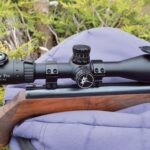Binocular Reviews Home > Thermal > Best Thermal Imaging Binoculars
It was not that long ago that you had to join the military or an elite police force in order to use any sort of thermal imaging device.
Thankfully for us, this relatively new night vision technology is now readily available to the general public and whilst for most people the prices cannot be regarded as cheap, but they continue to come down as the level of competition between the increasing number of brands who enter the NV market increases.
So only a few years ago your choice of thermal imaging binoculars and bi-oculars was extremely limited, but now there is a good selection to choose from and so I decided that it was high time to take a look at what is out there and compare some of the best.
Please note that in this guide I will be recommending both binoculars and bi-oculars and whilst technically different, I have grouped them together for convenience and to make it easier to compare:
Bi-ocular vs Binocular – What’s the difference?
One of the fist things you will notice when you start researching thermal optics where you can look through them with both eyes is that you are presented with both thermal bi-oculars and binoculars.
So what is the difference? Well a true thermal binocular has two objective lenses, that collect information from each of them, whilst a bi-ocular only has one objective lens, but has an eye-piece arrangement that allows you to look at the image it generates with both eyes.
These obviously both differ from thermal monoculars which only have one lens and you can only view the image with one eye.
The advantage of a true binocular is that with the same size lenses, it collects double the amount of information as a single lens this can lead to a higher quality image and better night vision. On top of this you get a better stereo effect for improve distance perception.
On the down side it costs more to make two lenses, which can in turn, but not always lead to a more expensive product. Binoculars are also often a little heavier as well.
The advantage of a bi-ocular over a monocular is that like a true binocular, it is much easier to see and use with both eyes and you get a much better, more immersive experience.
Ok, so now that we have that out of the way, lets get down to the selections:
The Best? My choices as to what I believe are the top thermal vision binoculars for 2024 are based not only on the specifications and features, but I also took into consideration how much the unit costs.
It would be easy to say that a product with all the top features and latest components is the best and you maybe right. But they won’t necessarily be affordable or good value.
So I guess strictly speaking these are actually my pics of the best thermal binoculars for the money:
First up is the very impressive and only true thermal vision binoculars on the list, the ATN BinoX-THD series:
Next is the BHS-X Command Thermal Bi-ocular from FLIR.
Initially I was going to select their more popular model within this price range, the FLIR Scout BTS-X Pro, however I noticed that the BHS-X has number of better features, including a higher frame rate (30 Hz / 8 Hz vs 7Hz):
Third on my list of contenders to the best value thermal binoculars is another bi-ocular, the Armasight Helios 336 3-12×42:
Conclusion
At the moment and at the current price levels, I find it hard to look at anything past the ATN BinoX-THD.
A true binocular with more and better features and at a price that matches or beats all of the competition and which is why it is my choice as the best thermal binoculars for the money no question.
I would love to know your thoughts and which other devices I should take a look at and consider adding to this list. You can contact me via the link at the foot of this page.
Alternative Options
If your available budget does not quite extend out to affording a thermal binocular, you do still have a number of excellent options to explore:
- Best Thermal Monoculars under $600











































